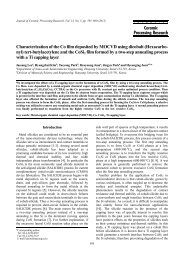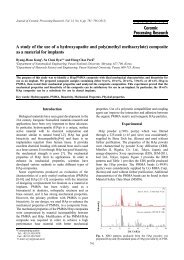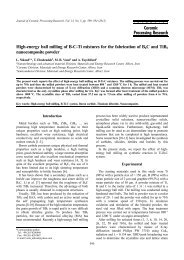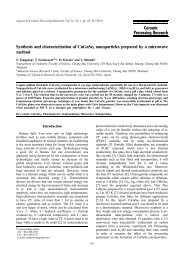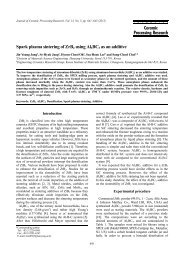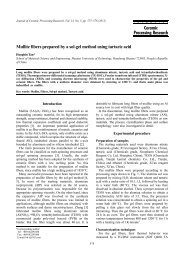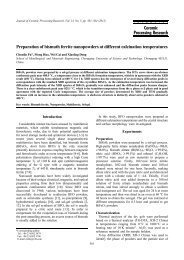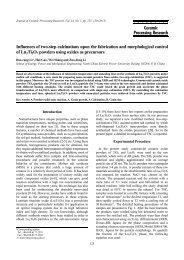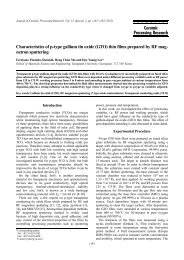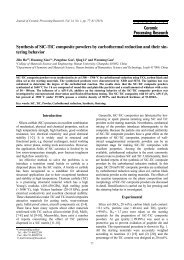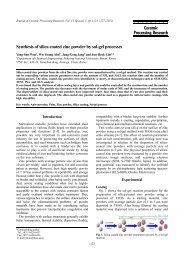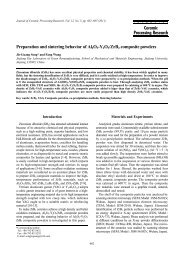Synthesis of PbTiO3 nanowires via a simple hydrothermal method
Synthesis of PbTiO3 nanowires via a simple hydrothermal method
Synthesis of PbTiO3 nanowires via a simple hydrothermal method
Create successful ePaper yourself
Turn your PDF publications into a flip-book with our unique Google optimized e-Paper software.
Journal <strong>of</strong> Ceramic Processing Research. Vol. 14, No. 1, pp. 114~116 (2013)<br />
J O U R N A L O F<br />
Ceramic<br />
Processing Research<br />
<strong>Synthesis</strong> <strong>of</strong> PbTiO 3 <strong>nanowires</strong> <strong>via</strong> a <strong>simple</strong> <strong>hydrothermal</strong> <strong>method</strong><br />
Yonggang Wang*, Linlin Yang, Yujiang Wang and Xia<strong>of</strong>eng Wang<br />
Department <strong>of</strong> Materials Science and Engineering, Luoyang Institute <strong>of</strong> Science and Technology, Luoyang 471023, PR China<br />
PbTiO 3 <strong>nanowires</strong> with diameters <strong>of</strong> 20-30 nm and lengths <strong>of</strong> about 2-3 um have been synthesized by a <strong>simple</strong> surfactant-free<br />
<strong>hydrothermal</strong> <strong>method</strong>. The resulting products were characterized by X-ray powder diffraction (XRD), energy dispersive X-ray<br />
spectroscopy (EDX), and scanning electron microscopy (SEM). It was found that KOH concentration played an important role<br />
in the formation <strong>of</strong> large quantities <strong>of</strong> PbTiO 3 <strong>nanowires</strong> and a possible mechanism for the formation <strong>of</strong> <strong>nanowires</strong> is discussed.<br />
Key words: Hydrothermal, PbTiO 3 <strong>nanowires</strong>.<br />
Introduction<br />
Nanoscale one-dimensional (1D) materials, such as<br />
nanotubes, nanorods, <strong>nanowires</strong>, and nanobelts, have<br />
become the focus <strong>of</strong> intensive research owing to their<br />
wide range <strong>of</strong> potential applications in nanodevices [1-<br />
4]. Differing from those <strong>of</strong> their bulk counterparts, the<br />
magnetic, optical and electric properties <strong>of</strong> these<br />
nanosturctured materials are very special due to their<br />
reduced size and large surface-to-volume ratios. Lead<br />
titanate (PbTiO 3 ) is an important ferroelectric and<br />
piezoelectric material, which exhibits a perovskite<br />
structure and a Curie temperature <strong>of</strong> 490 ο C [5].<br />
A sol-gel template and molten salt <strong>method</strong>s have<br />
been reported for the synthesis <strong>of</strong> PbTiO 3 (abbre<strong>via</strong>ted<br />
to PTO) <strong>nanowires</strong>, nanotubes, and nanorods [6-12].<br />
A <strong>hydrothermal</strong> <strong>method</strong> is a promising route to prepare<br />
nanomaterials at low temperature. Recently, PTO <strong>nanowires</strong><br />
have been fabricated by a surfactant-free <strong>hydrothermal</strong><br />
<strong>method</strong> [13], but the quantity <strong>of</strong> PTO <strong>nanowires</strong> also<br />
needs to be improved. A <strong>simple</strong> <strong>method</strong> to synthesize<br />
large scale one-dimensional materials at a low temperature<br />
has been a goal for many researchers in this field.<br />
In this paper, we report a large scale synthesis <strong>of</strong><br />
PTO <strong>nanowires</strong> by a <strong>simple</strong> surfactant-free <strong>hydrothermal</strong><br />
<strong>method</strong>.<br />
Next, equivalent amounts <strong>of</strong> Pb(NO 3 ) 2 solution was<br />
dropped into the suspension under constant magnetic<br />
stirring. Then, the suspension was filtered with distilled<br />
water to remove NO 3 - , CO 3 2- , and K + ions. Then, the<br />
precipitate obtained was poured into a stainless-steel<br />
autoclave with a KOH solution for the <strong>hydrothermal</strong><br />
treatment. The autoclave was sealed, heated up to<br />
200 ο C and held for 24 h, and then cooled to room<br />
temperature naturally. The products were filtered, washed<br />
with distilled water and absolute ethanol several times,<br />
and then dried at 70 ο C for 4 h for characterization.<br />
X-ray diffraction was performed on a Rigaku X-ray<br />
diffractometer with high-intensity CuKα radiation.<br />
Scanning electron microscope (SEM) images were<br />
obtained from a SIRION field-emission scanning electron<br />
microscope with EDX equipment.<br />
Results and Discussion<br />
Fig. 1 shows XRD patterns <strong>of</strong> the samples prepared<br />
by the <strong>hydrothermal</strong> process at 200 ο C for 24 h using<br />
KOH concentrations <strong>of</strong> 4, 6, 8, and 10M. All XRD<br />
Experimental<br />
All the chemicals were <strong>of</strong> analytical grade purity.<br />
Based on the nominal composition <strong>of</strong> PbTiO 3 , a stoichiometric<br />
amount <strong>of</strong> Ti(SO 4 ) 2 was dissolved in a dilute HNO 3<br />
solution to form a Ti 4+ solution. Subsequently, the<br />
Ti(CO 3 ) 2 suspension was prepared by introducing the<br />
mixed solution into a K 2 CO 3 solution under stirring.<br />
*Corresponding author:<br />
Tel : +86-379-65928196<br />
Fax: +86-379-65928196<br />
E-mail: wangyg968@yahoo.com.cn<br />
114<br />
Fig. 1. XRD patterns <strong>of</strong> the as-prepared PTO samples synthesized<br />
by the <strong>hydrothermal</strong> process at 200 o C for 24 h using KOH<br />
concentrations <strong>of</strong> 4, 6, 8, and 10M, respectively.
<strong>Synthesis</strong> <strong>of</strong> PbTiO 3 <strong>nanowires</strong> <strong>via</strong> a <strong>simple</strong> <strong>hydrothermal</strong> <strong>method</strong> 115<br />
Fig. 3. The proposed model <strong>of</strong> the growth <strong>of</strong> PTO <strong>nanowires</strong>.<br />
Fig. 2. SEM images <strong>of</strong> the as-prepared PTO samples synthesized<br />
by the <strong>hydrothermal</strong> process at 200 ο C for 24 h with KOH<br />
concentrations <strong>of</strong> (a) 4M, (b) 6M, (c) 8M, and (d) 10M. (e) The<br />
EDX spectroscopy pattern for the as-prepared PTO <strong>nanowires</strong>.<br />
patterns can be indexed to a pure tetragonal structure <strong>of</strong><br />
PTO, consistent with the reported data (JCPDS:77-2002).<br />
However, when the KOH concentration increases from<br />
4M to 10M, the intensities <strong>of</strong> diffraction peaks become<br />
weaker and broader. Furthermore, the (110) diffraction<br />
peaks becomes stronger compared with the (101) peaks.<br />
This implies that the KOH concentration has a great effect<br />
on the crystallization and evolution <strong>of</strong> PTO particles and<br />
may favor the growth orientation <strong>of</strong> the particles.<br />
Fig. 2 displays SEM images <strong>of</strong> the PTO samples<br />
prepared by the <strong>hydrothermal</strong> process at 200 ο C for<br />
24 h with KOH concentrations <strong>of</strong> 4M, 6M, 8M, and<br />
10M. It is worth pointing out that the morphology <strong>of</strong><br />
the as-prepared PTO particles varied obviously with the<br />
KOH concentration. The PTO sample prepared with a<br />
4M KOH concentration exhibits irregular particles with<br />
an average size <strong>of</strong> ca. 200 nm [Fig. 2(a)]. Interestingly,<br />
a small quantity <strong>of</strong> nanorods with diameters <strong>of</strong> 30-<br />
40 nm and lengths <strong>of</strong> about 200-400 nm began to<br />
appear on increasing the KOH concentration to 6M<br />
[Fig. 2(b)], and PTO <strong>nanowires</strong> instead <strong>of</strong> PTO<br />
nanorods was formed at 8M KOH [Fig. 2(c)]. As<br />
shown in Fig. 2(d), as the KOH concentration was<br />
further increased to 10M, PTO particles consist <strong>of</strong><br />
uniform <strong>nanowires</strong> with diameters <strong>of</strong> 20-30 nm and<br />
lengths <strong>of</strong> about 2-3 um. The ratio <strong>of</strong> Pb, Ti and O,<br />
determined by EDS (Fig. 2e) taken on the <strong>nanowires</strong><br />
obtained, is about 1:1:3, further demonstrating that<br />
PTO <strong>nanowires</strong> have been synthesized successfully.<br />
Obviously, in the present study, the KOH concentration<br />
played a key role in promoting the growth orientation<br />
<strong>of</strong> the PTO <strong>nanowires</strong>.<br />
The growth <strong>of</strong> the nanorods should be essentially<br />
attributed to the high concentration <strong>of</strong> OH - ions and<br />
their adsorption on PTO particles. It is believed that<br />
KOH behaves not only as a mineralizer but also as a<br />
surfactant in the <strong>hydrothermal</strong> process [14]. The OH -<br />
ions as a surfactant form ‘‘shells’’ surrounding the PTO<br />
particles, promoting the fabrication <strong>of</strong> the 1D nanostructures,<br />
as shown in Fig. 3. In addition, the formation<br />
<strong>of</strong> PTO <strong>nanowires</strong> also depends on the type <strong>of</strong> the<br />
precursor. PTO <strong>nanowires</strong> could not be obtained when<br />
Ti(OH) 4 and Pb(OH) 2 were used as precursors instead <strong>of</strong><br />
Ti(CO 3 ) 2 and PbCO 3 , which may be attributed to the<br />
difference in solubility between the carbonate and<br />
hydroxide. As the reaction mechanism and <strong>hydrothermal</strong><br />
conditions are complicated, the exact reason<br />
for the PTO <strong>nanowires</strong> being synthesized in the present<br />
<strong>method</strong> needs to be further investigated.<br />
Conclusions<br />
PTO <strong>nanowires</strong> with diameters <strong>of</strong> 20-30 nm and<br />
lengths <strong>of</strong> about 2-3 um have been successfully<br />
prepared by a <strong>simple</strong> <strong>hydrothermal</strong> <strong>method</strong> without any<br />
surfactants. It was found that the KOH concentration<br />
played a key role in controlling the formation <strong>of</strong> PTO<br />
<strong>nanowires</strong>. A large quantity <strong>of</strong> PTO <strong>nanowires</strong> could be<br />
synthesized when the KOH concentration was increased<br />
to 8 M. It is rational to expect that PbZr 0.52 Ti 0.48 O 3 and<br />
PbZrO 3 <strong>nanowires</strong> may be synthesized by this surfactantfree<br />
<strong>hydrothermal</strong> <strong>method</strong>, and this work is in progress.<br />
Acknowledgement<br />
This work is supported by the Doctor Foundation <strong>of</strong><br />
Luoyang Institute <strong>of</strong> Science and Technology (2009BZ05).<br />
References<br />
1. X.F. Duan, Y. Huang, Y. Cui, J. Wang and C.M. Lieber.<br />
Nature. 409 (2001) 66-69.<br />
2. W. Wang, C. Xu, G. Wang, Y. Liu and C. Zheng. Adv.
116 Yonggang Wang, Linlin Yang, Yujiang Wang and Xia<strong>of</strong>eng Wang<br />
Mater. 14 (2002) 837-840.<br />
3. S. Zhang, L.M. Peng, Q. Chen, G.H. Du, G. Dawson and<br />
W.Z. Zhou. Phys. Rev. Lett. 91 (2003) 256103-256111.<br />
4. Y. Liu, C. Zheng, W. Wang, Y. Zhan and G.H. Wang. J.<br />
Am. Ceram. Soc. 85 (2002) 3120-3122.<br />
5. G. Burns and B.A. Scott. Phys. Rev B. 7 (1973) 3088-3101.<br />
6. B.A. Hernandez, K.S. Chang, E.R. Fisher and P.K.<br />
Dorhout. Chem. Mater. 14 (2002) 480-482.<br />
7. P.M. Rørvik, K. Tadanaga, M. Tatsumisago, T. Grande and<br />
M.A. Einarsrud. J. Eur. Ceram. Soc. 29 (2009) 2575-2579.<br />
8. K.S. Chang, Y.H. Park, S.D. Bu, B.A. Hernandez, E.R.<br />
Fisher and P.K. Dorhout. Opt. Mater. 30 (2007) 132-134.<br />
9. Z.Y. Cai, X.R. Xing, R.B.Yu, X.Y. Sun and G.R. Liu. Inorg.<br />
Chem 46 (2007) 7423-7427.<br />
10. M.C. Hsu, I.C. Leu, Y.M. Sun and M.H. Hon. J. Solid State<br />
Chem. 179 (2006) 1421-1425.<br />
11. Y. Deng, J.L. Wang, K.R. Zhu, M.S. Zhang, J.M. Hong,<br />
Q.R. Gu and Z. Yin. Mater. Lett. 59 (2005) 3272-3275.<br />
12. L.F. Liu, T.Y. Ning, Y. Rena, Z.H.Sun, F.F. Wang,W.Y.<br />
Zhou, S.H. Xie, L. Song and S.D. Luo. Mater. Sci. Eng. B.<br />
149 (2008) 41-46.<br />
13. Y.M. Hu, H.S. Gu, X.C. Sun and J.You. Appl. Phys. Lett.<br />
88 (2006) 193120-193123.<br />
14. J.T. Han, Y.H. Huang, X.J. Wu, C.L. Wu, W. Wei, B. Peng,<br />
W. Huang and J.B. Goodenough. Adv. Mater. 18 (2006)<br />
2145-2148.



